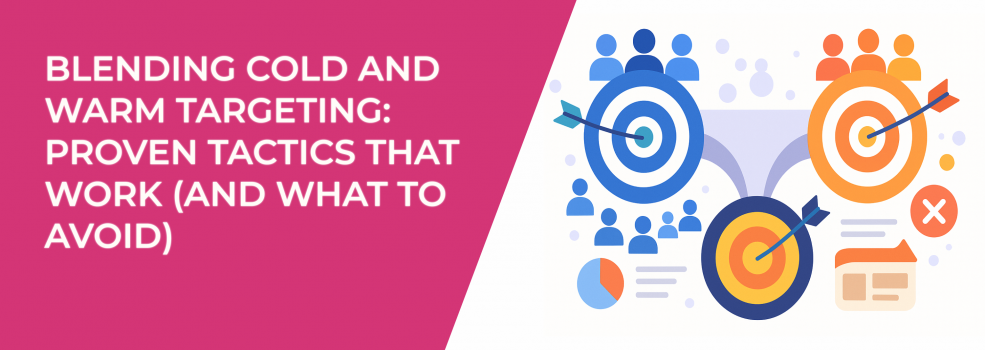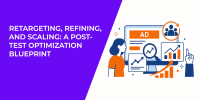Advertising on Facebook and Instagram in 2025 isn’t just about picking the right audience or creative. It’s about building a dynamic system — one where new prospects are consistently engaged, and existing ones are guided toward action.
That system depends on how well you blend cold and warm targeting.
Done well, it creates a funnel that flows from discovery to decision using data, relevance, and thoughtful automation. Done poorly, it leads to bloated ad costs, confused messaging, and audiences that burn out before they convert.
Let’s unpack how to build this properly and where Meta’s Advantage+ targeting options actually fit into the strategy.
Cold vs. Warm Targeting: What’s the Difference and Why It Matters
Start with the basics. Cold targeting means reaching people who haven’t interacted with your brand — no clicks, visits, or video views. These users are completely new. Your job is to introduce, not sell.
Warm audiences are already familiar. Maybe they clicked an ad, visited your site, or watched a video. They’re closer to taking action, but they may still need more information or reassurance before converting.
Most advertisers focus on one or the other. But real performance comes when you connect the two. Cold audiences bring people in. Warm audiences keep them moving.
This isn’t about running separate campaigns. It’s about creating a clear, intentional progression.
How to Approach Cold Targeting
Meta has reduced many interest categories and behavioral targeting options, so reaching new people requires more strategic thinking.
What works now:
-
Target based on community engagement. Focus on users active in relevant Facebook groups or Instagram pages.
-
Use engagement signals. Behavior such as post interactions or video views matters more than static demographics.
-
Avoid over-filtering. Ultra-specific targeting limits reach and slows learning.
-
Lead with value. Instead of a product pitch, use storytelling, education, or useful tips to grab attention.
Think of cold targeting as the first handshake. It’s not about conversion. It’s about getting noticed by the right people in the right context.
If you’re just getting started or want a refresher, Facebook Ad Targeting 101: How to Reach the Right Audience walks through core principles in detail.
Where Advantage+ Targeting Fits into Cold and Warm Strategies
Meta’s Advantage+ tools are designed to simplify and scale your targeting, but they work best when layered into a structured funnel — not used blindly.
Here’s how to use them effectively in a blended cold-to-warm strategy:
-
Advantage+ Audience: Use this when launching cold campaigns with broad creative. It helps Meta find potentially interested users beyond your selected parameters. However, avoid it if you're testing new targeting concepts or need clarity on which audiences perform best.
-
Advantage Detailed Targeting: This expands your audience beyond your chosen interests. It’s useful for reach but reduces your control over who actually sees your ads. Best suited for awareness campaigns with flexible targeting.
-
Advantage+ Lookalikes: These work well for cold targeting when you have a strong seed audience. Still, treat them as new users. Don’t assume they’re ready to convert without a clear introduction.
-
Advantage+ Custom Audience Expansion: Be cautious here. If you’re running warm campaigns tied to specific actions — like add-to-cart or video views — expanding the audience may weaken the impact. Turn it off for precise retargeting.
-
Advantage Campaign Budget: This automatically distributes budget across ad sets. It’s helpful when scaling cold ads with similar goals but not ideal for warm campaigns targeting multiple audience segments with distinct messages.
Used intentionally, Advantage+ tools can improve efficiency and scale. But if applied everywhere, they blur the line between cold and warm audiences and make it harder to control the customer journey.
For a detailed breakdown of the pros and cons of automation, check out Meta Advantage+ or Manual Setup? How to Make the Right Choice.
Turning Cold Traffic into Warm Audiences
Once someone clicks your ad, watches your video, or visits your website, they move from cold to warm. But they’re not ready to buy just yet.
To keep them engaged:
-
Segment by behavior. Distinguish between someone who visited your homepage and someone who spent time on a product page.
-
Follow up with tailored content. Reviews, how-to videos, or feature highlights work better than repeating the same cold ad.
-
Control frequency. Don’t bombard people with the same message. Warm audiences get tired faster if your content isn’t evolving.
-
Stay relevant to their entry point. If a user engaged with content about sustainability, keep that theme in your retargeting.
This phase is all about trust. The more personalized and helpful your follow-up, the more likely people are to keep moving forward.
Nailing Retargeting Without Common Mistakes
Retargeting fails when advertisers treat all warm users the same. But each user behaves differently, and your ads should reflect that.
Here’s how to retarget effectively:
-
Create separate ad sets based on behavior. Group users by what they did — video views, product page visits, cart abandons.
-
Customize creative for each segment. A user who read your blog isn’t ready for the same pitch as someone who almost checked out.
-
Update creative frequently. Warm audiences have short attention spans. Repetitive ads don’t build trust — they create fatigue.
-
Exclude recent buyers. Don’t waste ad spend targeting users who’ve already converted.
Treating warm audiences with this level of care leads to more efficient ad spend and better results. It's a precision game, not a volume one.
This step-by-step guide on How to Set Up Facebook Retargeting shows exactly how to do it effectively.
Avoiding Overlap and Campaign Confusion
Blending cold and warm targeting without structure leads to inflated frequency, duplicated impressions, and confused metrics.
To stay in control:
-
Exclude warm audiences from cold ad sets. This prevents mixed messaging and keeps your funnel stages clean.
-
Use Meta’s audience overlap tool. Spot and fix duplicated targeting between campaigns.
-
Match messaging to the audience’s stage. Don’t serve introductory content to people already familiar with your brand.
The goal is to move people through your funnel — not keep them stuck in the same loop. With clear exclusions and tailored messages, your ads become more relevant and more effective.
Learn how and when to apply exclusions in When to Use Exclude Targeting on Facebook and Why It Matters.
Structuring a Funnel That Feels Natural
A good funnel isn't linear. People move back and forth, pause, or skip steps. Your campaign structure should reflect that — with enough flexibility to respond, and enough clarity to guide.
Here’s a basic layout:
Cold (Awareness)
-
Objective: Awareness or engagement.
-
Tools: Advantage+ Audience (with limits), broad targeting, community targeting for specific niches.
-
Message: Introduce a relatable problem, story, or insight.
Warm (Consideration)
-
Objective: Traffic or leads.
-
Tools: Retargeting based on engagement.
-
Message: Show social proof, comparisons, or deeper value.
Hot (Conversion)
-
Objective: Sales or app promotion.
-
Tools: Cart/page view audiences, no expansion.
-
Message: Offer a strong CTA, use urgency or trust-building cues.
Each stage should feel like the next logical step. And if someone skips ahead or drops back, your system should be ready to adjust.
Final Thoughts
Cold and warm targeting don’t belong in separate silos. The best-performing campaigns combine both with intention — built around user behavior, not platform shortcuts.
Meta’s Advantage+ tools can be incredibly useful. But they’re not a replacement for strategy. Use them to support your structure, not override it.
When each campaign has a clear role, and each audience receives the message they actually need, your funnel stops feeling like marketing and starts working like a conversation.
That’s how you scale performance, reduce waste, and stay ahead.

